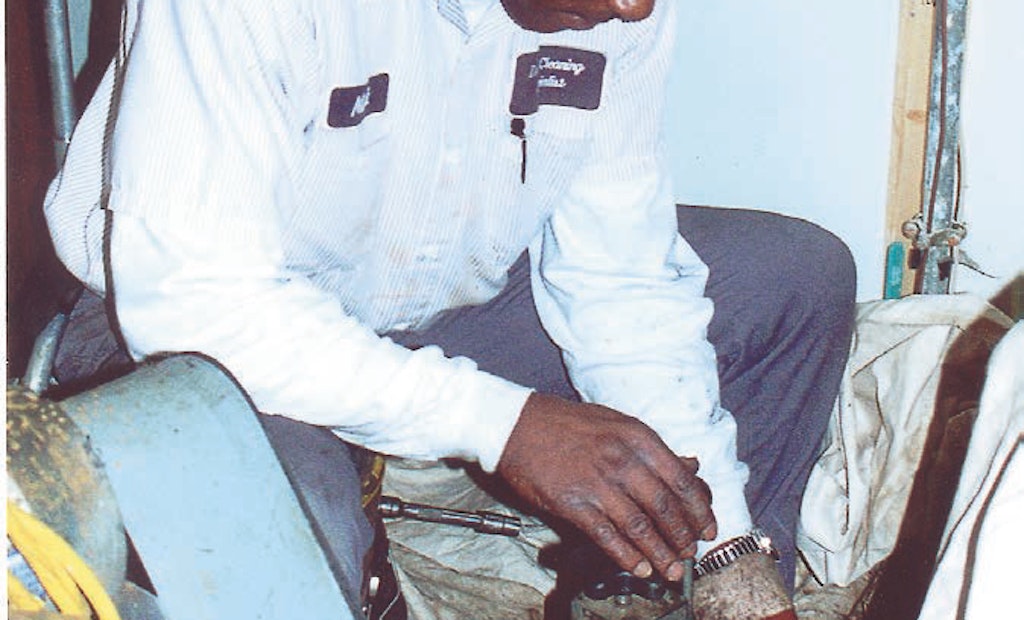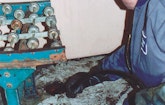
Interested in Trucks?
Get Trucks articles, news and videos right in your inbox! Sign up now.
Trucks + Get AlertsTake a look at the Drain King Inc. article featured 10 years ago in the February 2003 issue of Cleaner magazine. We spotlight the company again in a follow-up story to see how the business has evolved over the last decade: “Expansion Spells Success for Drain King.”
Ten years ago, Bill Schiller went from unemployment line to entrepreneur, and never looked back.
Laid off from his nursing job, Bill was doing some serious couch time when one of his home drains clogged up and he had to call for help. With nothing better to do, he watched the cleaning technicians work and asked all kinds of questions about the job: equipment, hours, money. He realized that, aside from the possibility of good profits, drain cleaning offered an extra.
“It’s the only job I’ve ever had where everyone’s always happy to see you, every time,” says Bill. “It’s probably the most gratifying job I’ve ever encountered. Every job is a morale boost for you. You get energized by the customers letting you know how happy they are to see you in their doorway.”
After doing the math, Bill decided to give the business a try. To get his foot in the door and learn the ropes, he subcontracted to established cleaners, with his own truck but no equipment. He saved enough to buy some equipment of his own, then hung out his own shingle as Drain King, based in Blaine, Minn.
He bought a small Mustang electric-powered water jetter, adequate for clearing 2-inch pipes. Then he added 200 feet of hose to service deli and kitchen station lines in downtown Twin Cities buildings. Today, Drain King cleans 10,000 drains per year.
Trading referrals
Among Bill’s first moves in the new business was to take out a quarter-page ad in the Yellow Pages for $650 per month – more than his mortgage payment. To ensure a steady income, he talked with area plumbers to gauge their interest in subcontracting. Most had no commitments to anyone in the drain cleaning field. Seizing the opportunity, Bill offered to trade out job referrals.
The plumbers were receptive because they saw an opportunity to expand their services without buying new equipment or adding staff. They agreed to trade referrals if Bill would clean the drains not using the Drain King name but functioning as part of their outfits. To build his experience and volume, he agreed to work for 30 percent of job fees.
Later, when he was also subcontracting to larger cleaning firms, he bumped that fee to 50 percent. By 1994, he was busy enough to feel confident telling the plumbers that he was moving to a full rate structure. They’d still have the convenience of all his services, but he’d get the full fee he wanted.
“I realized that by offering this variety of services, we were worth the premium, because ultimately it saves them scheduling another call,” says Bill. So in April 1995, Drain King incorporated, and Bill took on a partner. Art Kallenbach, whom he met through a business referral, became vice president, buying 25 percent of the business.
Bill’s wife Kim is co-owner of Bill’s interest in Drain King. His mom, Kathy Schiller, is the bookkeeper, and his brother-in-law, Kent Smith, is the business manager.
Subcontract tango
Since the business incorporated, Drain King has charged plumbers its direct retail price, which the contractors then mark up. How is Drain King able to do this and still maintain its subcontracting customers? By not selling based on price.
Like a closely choreographed dance, the subcontracting arrangement is a mutually rewarding cycle of high expectations and consistently excellent performance. On price, Bill says, “We probably sit right about average, so that allows our plumbing contractors to be on the high end, but still within the acceptable range.” What keeps them coming back is Drain King’s dedication to flawless customer service.
It begins with a commitment to run a tight ship that includes well-groomed, uniformed technicians thoroughly trained with customer satisfaction as their primary goal. The follow-through is accomplished by clean trucks stocked with a wide range of well-maintained equipment. This allows technicians to conveniently perform unexpected ancillary services.
“We can knock it all out right there, without having to re-schedule,” says Bill. “For a lot of people,” he explains, “perceived value is worth the extra charge when they don’t get guys showing up in ripped jeans and T-shirts.”
The vans and equipment trailers used in subcontracting jobs are unmarked, and the uniforms carry no logos, just patches with the words: “Drain Cleaning Specialist” and the technician’s name on them. This maintains the customer perception that drain cleaning is just another service offered by the plumbers they already know and trust.
Bill encourages Drain King technicians to go the extra mile on customer sites, such as by cleaning up areas they may not have actually worked in. The plumbing contractors notice, and they have come to depend on Drain King as a partner.
Ahead of the game
As a result, the business keeps growing. The Drain King equipment fleet includes a Camel Jet municipal jetter (Super Products Corp.) on a diesel truck, capable of 60 gpm @ 2,000 psi for sewer lines 4 to 36 inches; a Gem-Jet trailer jetter (Lely USA) using 15 gpm @ 1,000 psi to clear 4- to 6-inch metal or plastic lines; and 11 service vans.
Each van carries Ken-Way cable equipment, a waterjet cleaning rig (3,000 psi Northern Hydraulics gasoline-powered pressure washer with a CAT pump run on an 11 to 13 hp motor) and a push camera from MyTana Manufacturing Co. with 200 to 300 feet of cable. A Chevy S-10 pickup pulls a customized trailer vacuum unit built on a Mudsucker directional boring body to negotiate the 6- to 7-foot clearances in low parking garages.
Service work continues to drive the company. When Bill began subcontracting, his billings split out at an average of 60 percent direct sales and 40 percent subcontracted. Today, the breakdown is 79 percent direct and 21 percent subcontracted. Why? A big drop in subcontracting came after the September 11 attacks. “Before that, subcontracted billings were around 37 percent,” he says. “I think maybe people are more apt now to buy or rent the snakes and try to fix it themselves.”
Like most others in a tough economy, Drain King must make a constant effort to keep its name in front of existing and potential customers. Drain King gets plenty of repeat business, but developing new customers is an ongoing challenge, one Bill meets with a can-do attitude.
Aggressive promoter
Drain King still advertises in the Yellow Pages, spending $110,000 a year on a three-quarter-page ad in the plumbing sections and half-page ad in the sewer contractor categories of the Twin Cities, Brainerd, and St. Cloud books. But Bill cautions against depending solely on that form of advertising: “You can’t make a business in drain cleaning out of the phone book.”
So what else does Drain King do? Employees use slow times to make phone calls or personal visits to potential customers. Whenever they drop in on a prospect, they leave business cards and stickers.
Bill also outlines another, less common approach. “To make sure our name is out there with municipalities, we always call them after we’ve cleaned out a main sewer line. This also makes them aware of the condition of their systems so they don’t end up with block-long backups.”
Between its “service is everything” attitude, an active sales building effort and an instinctive understanding of marketing techniques, Drain King is positioned to surmount a sluggish economy. This is one company whose work may be mostly underground, but whose future appears poised to soar.
A HIRING CHALLENGE
One trouble spot along Drain King’s road to success came when the company tried to create a sales position. Business Manager Kent Smith had difficulty finding the right person for the job, and when several people didn’t work out, company managers took a second look at the hiring process.
“It was a learning process from the get-go,” Kent admits. “Smaller drain cleaning companies haven’t really tried a lot of concerted selling, so we were kind of on our own. Through hard experience, we finally realized it’s more important to hire someone who knows the industry and then teach them to sell, than it is to hire a professional salesperson who doesn’t understand how this business works and can’t speak the language.”
Going back to the drawing board, Kent and Vice President Art Kallenbach teamed up to build their base of about 200 preventive maintenance clients to at least twice that size before hiring a dedicated salesperson. “That way, we’ll have a stable financial base to start a new person from,” Kent says. “Every new thing you try in business is a risk, but you have to have an established revenue base to back it up, so it won’t be a make-or-break situation. You have to know where your bottom line is, so if something fails, you won’t ruin the company.”
As for what part of the talent pool the new salesperson will come from, this time they’ll fish closer to home. “We’ll look internally,” says Kent, “possibly for a service tech who is interested in stepping into that position, or maybe someone who has worked in maintenance and wants to expand their career.”







